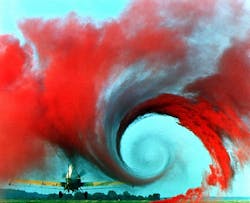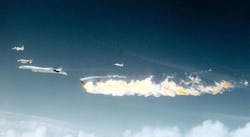The unseen airport killer: NASA works to mitigate the potentially deadly effects of wake vortex turbulence
HAMPTON, Va., 1 July 2012. It's been a silent and unseen airport killer that can cause aircraft on takeoff and landing to hit sudden and violent turbulence and slam the aircraft into the ground before pilots have time to take evasive action.
It's called wake vortex turbulence, and is particularly a threat to relatively small aircraft operating in close proximity to large airliners and jumbo jets. Although the phenomenon is invisible to the human eye, researchers at NASA are trying to improve airport defenses against the potential deadly effects of wake vortex turbulence.
The cause of this violent force is powerful air currents that swirl backward and outward from the wings of flying aircraft. Among the most dangerous times are when aircraft are lifting off from the runway or on short final approach to the airport.
If a smaller aircraft follows too closely behind, that powerful swirling air can hit it with such force that it causes the pilot to lose control, or even flip the aircraft over too closely to the ground for its crew to recover quickly enough before a crash.
On 30 May 1972 Delta Air Lines flight 9570, a DC-9 narrow-body jetliner, crashed at the Greater Southwest International Airport in Fort Worth, Texas, while performing touch-and-go landings behind a much-larger DC-10 widebody.
The DC-9, which was landing behind the heavy DC-10, started to roll uncontrollably on short-final approach and struck the runway with its right wing, destroying the aircraft and killing the four people aboard. Investigators said wake vortex turbulence from the DC-10 caused the crash, and as a result the FAA created new rules for minimum following separation from large aircraft.
Years later on 15 Dec. 1993 a chartered business jet with In-N-Out Burger President Rich Snyder aboard crashed, killing Snyder and four others, while on approach to John Wayne Airport in Orange County, Calif. The small jet, which had been caught in wake vortex turbulence while following a Boeing 757 jetliner, rolled into a deep descent and crashed.
One of the most spectacular wake vortex turbulence aviation disasters in history happened in the New York area on 12 Nov. 2001 -- just two months after the 9-11 terrorist attack -- when American Airlines flight 587, an Airbus A300, crashed into the Belle Harbor neighborhood of Queens, N.Y., shortly after taking off from John F. Kennedy International Airport.
Investigators ruled pilot error as the primary cause of the crash when flight 587's pilot flew too closely to the wake turbulence of a Japan Airlines Boeing 747 heavy jet. The violent turbulence from the 747 tore the tail off American 587, investigators said, after crew members over-compensated with the jet's rudder to escape the sudden turbulence.
Things may be getting better, however. Researchers from the U.S. National Aeronautics and Space Administration (NASA) Langley Research Center in Hampton, Va., are working together with atmospheric experts from Aerospace Innovations, LLC in Yorktown, Va., to develop technology that will give pilots a fighting chance against the effects of wake vortex turbulence (story continues below).
NASA Langley awarded Aerospace Innovations a $605,730 contract last month for the Atmospheric Environment Safety Technologies (AEST) project, which will investigate sources of atmospheric flight hazards like wake vortex turbulence and provide technologies to avoid or mitigate them.
The AEST project supports wake vortex research through the NASA Atmospheric Hazard Sensing & Mitigation (AHSM) program, which seeks to detect and better-understand wake vortex behavior to provide for safer runway operations, and help aircraft avoid in-flight turbulence.
The goal of AEST research is to learn more about wake vortices and find ways to detect this phenomenon from arbitrary viewing angles from a moving aircraft, NASA Langley officials say.
Previous wake detection work has focused on tangential winds for detection, but the AEST project will expand axial flow or other phenomena. Aerospace Innovations researchers will look into wake vortex detection by developing software sensor models and atmospheric datasets with simulated vortices embedded.
Results of this research project may lead to improved airport sensors to give pilots early detection and awareness of potentially dangerous wake vortex turbulence.
For more information contact NASA Langley Research Center online at www.nasa.gov/centers/langley, or Aerospace Innovations, LLC at www.ai-llc.com.
Follow Avionics Intelligence news updates on Twitter, and join the revamped Avionics Intelligence group on Linkedin at www.linkedin.com/groups/Avionics-Intelligence.
About the Author
John Keller
Editor-in-Chief
John Keller is the Editor-in-Chief, Military & Aerospace Electronics Magazine--provides extensive coverage and analysis of enabling electronics and optoelectronic technologies in military, space and commercial aviation applications. John has been a member of the Military & Aerospace Electronics staff since 1989 and chief editor since 1995.

